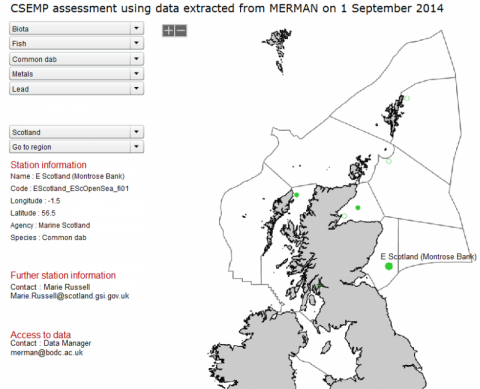Clean Seas Environment Monitoring Programme (CSEMP)
Nutrients such as nitrate, silicate and phosphate occur naturally and are essential for the growth of aquatic plants and form the basis of marine food webs. Nutrient concentrations are highest in winter, when biological nutrient uptake is at its minimum due to the decrease in sunlight and water temperature and low in summer due to their uptake by growing phytoplankton. Anthropogenic sources of nitrogen and phosphorous, including agricultural run-off and domestic and industrial waste disposal can result in elevated nutrient concentrations, particularly in coastal waters. This may result in eutrophication where waters have low dissolved oxygen and can be of poor quality. Eutrophication is defined as 'The enrichment of water by nutrients causing an accelerated growth of algae and higher plant forms to produce an undesirable disturbance to the balance of organisms present in the water and to the quality of the water concerned, and therefore refers to the undesirable effects resulting from anthropogenic enrichment by nutrients.' (OSPAR 2003).
Since 2001 surface water samples have been collected from Scottish coastal and offshore waters during January, and have been analysed for nutrients (nitrate, phosphate, silicate and ammonia) with the aim of establishing regional background nutrient concentrations and contributing towards an assessment of the eutrophication status of Scottish coastal and offshore waters.
Water Collection & Analysis
Surface water samples were collected at 15 minute intervals from the non-toxic water supply of FRV Scotia IV, during the MSS CSEMP cruise. The input for the non-toxic water supply is situated on the hull of the ship at a depth of ~ 4.5 m. Water samples were analysed at sea within 10 hours of collection (where possible) using a Bran & Luebbe QuAAtro continuous flow autoanalyser (pictured above). The method for analysis of nutrients in seawater is accredited to ISO17025 standards by the United Kingdom Accreditation Service.
Data Assessment
Nutrient data can be assessed against assessment criteria established by OSPAR as indicators of nutrient enrichment (OSPAR 2005). Background levels (or concentrations) and assessment levels (50% above background levels) are used to assess nutrient concentrations; concentrations above the assessment level may lead, in time, to an undesirable disturbance to the marine ecosystem. OSPAR assessment criteria are shown in the table below:
| Waters | Salinity range (reference level) | DIN Background contentration (µM) | Assessment Level (µM) |
|---|---|---|---|
| Estuarine | 20-30(25) | 20 | 30 |
| Coastal |
30-34 (Irish Sea) 34.5 North Sea (32) |
13 | 20 |
| Offshore |
>34 Irish Sea > 34.5 North Sea |
10 | 15 |
Dissolved inorganic nitrogen (DIN) is the sum of the concentration of total oxidised nitrogen (TOxN) and ammonia. Ammonia contributes only about 5% to the DIN concentration in Scottish regions


